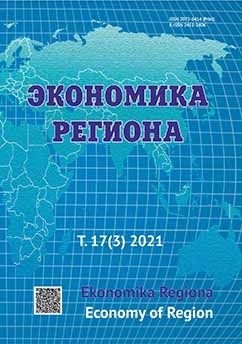Моделирование гетерогенности взаимовлияния регионов страны в сфере обрабатывающей промышленности
Modelling the Heterogeneity of the Mutual Influence between Russian Regions in the Manufacturing Industry
Author(s): Mikhail Borisovich Petrov, Leonid Aleksandrovich Serkov, Konstantin Borisovich KozhovSubject(s): Social Sciences, Economy, National Economy, Business Economy / Management, Socio-Economic Research
Published by: Институт экономики Уральского отделения Российской академии наук
Keywords: Sverdlovsk oblast; manufacturing industry; interregional relations; spatial autocorrelation; Moran’s I; weight matrix; spatial distribution; quantile regression;
Summary/Abstract: As factors affecting interregional interactions play an important role in regional economic development. Thus, developing a methodology for assessing these interactions is becoming urgent. The article proposes a methodological approach to analyse the factors influencing possible interactions between Sverdlovsk oblast and other constituent entities of the Russian Federation in the manufacturing industry. It is hypothesised that the elements of an interregional interaction matrix are proxy variables characterising the degree of this interaction. An economic analysis of relations and production chains between Sverdlovsk oblast and other constituent entitles confirmed this hypothesis. First, based on the spatial distribution of manufacturing output in the examined regions, values of an indicator showing the strength of their mutual influence were determined. Second, the impact of economic, infrastructural and institutional factors on the obtained indicator, characterising the inter action between Sverdlovsk oblast and other regions, was assessed using quantile regression. In this case, such a technique was chosen instead of the classical ordinary least squares (OLS) regression that incorrectly estimates the dependencies between the studied variables. This is expressed in the fact that the regression coefficients de pend on q-quantile of the dependent variable. We have revealed that price levels of the examined regions do not affect their possible interactions with Sverdlovsk oblast. Simultaneously, the dissemination of knowledge acts a driver of interaction between the considered regional manufacturing industries. The research findings can be used to prepare strategies, programmes and schemes for the placement and development of industries, considering the potential of Sverdlovsk oblast and other Russian regions.
Journal: Экономика региона
- Issue Year: 17/2021
- Issue No: 3
- Page Range: 944-955
- Page Count: 12
- Language: Russian

